Introduction
Sending and giving red packets (also called red envelopes, or lai see in Cantonese and hongbao in Mandarin) containing cash is a Chinese tradition at Lunar New Year. Leveraging this Chinese tradition, WeChat introduced a function to send digital red packets back in 2014, which has become hugely popular. This year, some 768 million WeChat users chose to send digital red packets to friends and families to bring good wishes to each other, and about 80% of mainland Chinese said they would send red packets via WeChat Pay this year, surpassing 69% who opt for physical red packets, according to a survey by market research firm Lightspeed Research.
WeChat has expanded its functions to money transfer, taxi ordering, online shopping, bill settlement and wealth management. Not only has the expansion of its functions further reinforced user engagement, but it also helped to more than double its market share in mobile payment to 39% in the third quarter of 2017 from 16% in the third quarter of 2015, according to research firm Analysys.
We believe WeChat’s success in digital red packets has made its users accustomed to sending and receiving money within the app. WeChat’s broad user base of over 1 billion MAU, as of February 2018, and high degree of user engagement, give the app a strong competitive edge to further develop its mobile payment, making it a viable threat to Alipay’s dominant market share in mobile payment in China.
Red Packets
Red packets, or red envelopes, are cash gifts that Chinese people traditionally give each other at Lunar New Year as well as at important life events such as wedding banquets. The red color of the packets symbolizes good fortune. In Southern China, red packets are given by married people to younger generations, while in Northern China, typically the elder generations, regardless of marital status, will give red packets to young people.The amount of the cash gift is based on the relationship between the sender and receiver. In general, the average Chinese person will give more money to relatives and less to acquaintances.
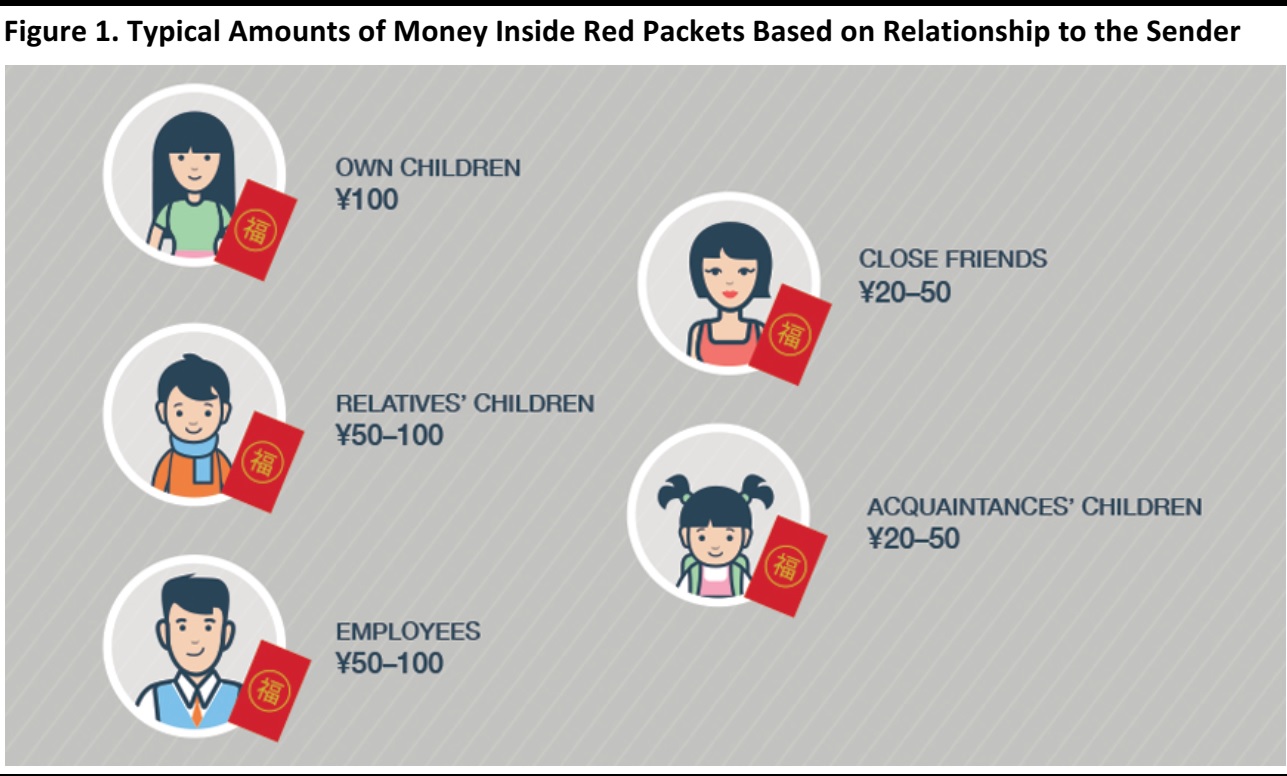 Source: Coresight Research
Source: Coresight Research
Origins of Lunar New Year and the Tradition of Giving Red Packets
The origin of Lunar New Year (also called Chinese New Year) started with a mythical beast call Nian that would appear on New Year’s Eve and eat livestock and people, especially children. With the help of an old man visiting their village,the people discovered that the beast was afraid of the color red and loud noises. After that,as the New Year approached, the villagers would wear red clothes and hang red lanterns and red spring scrolls on the windows and doors of their homes and used firecrackers to frighten away the beast.
Another mythical beast called Sui would terrify the children while they were asleep. One New Years, the parents gave their child some coins to play with to keep him awake, which he wrapped with red paper. This seemed to scare away the demon, and so giving red envelopes with money became a tradition to keep children safe and to ward off evil spirits.
Digital Red Packets—WeChat Leading the Trend
In 2014, WeChat introduced a function on its app that allowed users to send digital red packets during Lunar New Year to friends and groups within the app. The feature gained popularity with a promotional giveaway held during the broadcaster CCTV’s New Year’s Gala, the most-watched television special in the country, where viewers could win WeChat digital red packets as prizes.
Since then, the number of digital red packets sent by WeChat users during Lunar New Year has increased exponentially. In 2015, WeChat users sent 3 billion digital red packets via WeChat at Lunar New Year. This grew tenfold to 32 billion in 2016 and to 46 billion in 2017.
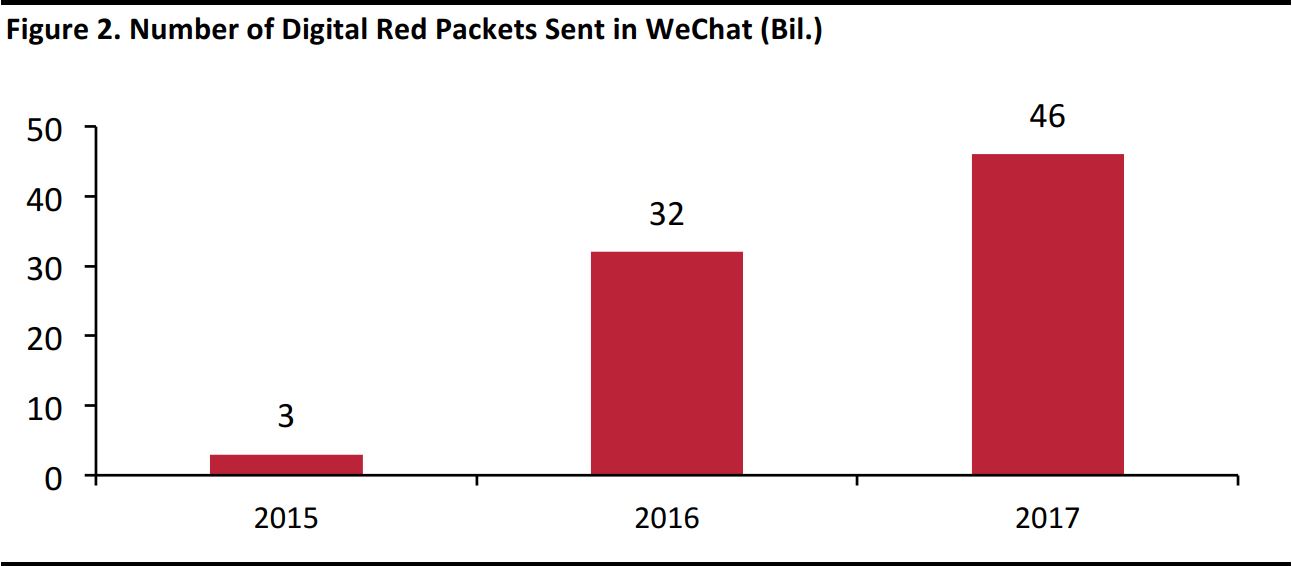 Source: Tencent/Bloomberg/Coresight Research
Source: Tencent/Bloomberg/Coresight Research
WeChat’s Digital Red Packets at Lunar New Year 2018
This year, 768 million WeChat users chose to send digital red packets to friends and families to bring good wishes to each other, an increase of 10% year over year. On average,each WeChat user sent approximately 60–70 digital red packets via WeChat.
According to a survey conducted ahead of Lunar New Year this year by market research firm Lightspeed Research, about 80%of mainland Chinese said they would send red packets via WeChat Pay this year. This surpassed the 69% of respondents who opt to send physical red packets and the 31% who chose to send on Alipay.
 Source: Lightspeed Research
Source: Lightspeed Research
This result does not necessarily imply that Chinese people are switching to virtual red packets from physical red packets, and we expect parents and seniors to continue to give physical red packets to younger generations. However, what this does signify is that WeChat has widened the “market” for red packets.
One of the reasons behind the popularity of WeChat’s red packets is that it gamifies the tradition of giving red packets in a digital setting. One no longer needs to follow the traditional rules that only married people or older generations can send physical red packets to younger generations. WeChat allows users to send digital red packets to friends and family for fun and for good wishes,without the need to adhere to the old traditions of relationship or seniority and who gives to whom and how much they give.In addition, they can send and receive digital red packets multiple times in groups or individually. This partially explains why more and more Chinese people are choosing to send digital red packets rather than give physical red packets.
 Source: Tencent/Tieba
Source: Tencent/Tieba
WeChat’s Successful Foray into Mobile Payment,Leveraging the Popularity of Digital Red Packets
The gamification of sending and receiving digital red packets has successfully encouraged WeChat users to link their bank account information to their WeChat accounts and has accustomed them to sending and receiving money in the app.
The WeChat app has since expanded its functions to include money transfer, taxi ordering, online shopping, bill settlement and wealth management. WeChat users can stay in the app for various online and offline services from ordering to payment, further reinforcing its users’ engagement within the app and marking WeChat’s successful foray into the mobile payment market.
 Source: Tencent/Digital Initiative Digest/Coresight Research
Source: Tencent/Digital Initiative Digest/Coresight Research
China’s Mobile Payment Market
The growth of the mobile payment market has accelerated meaningfully since 2016, much like the exponential growth seen in digital red packets sent by WeChat users. Not only has the popularity of WeChat’s digital red packets allowed it to gain share of the mobile payment market, but it has also helped to expand the market itself. According to iResearch, the Chinese mobile payment market will reach ¥165.9 trillion (US$26.4 trillion) in 2018 and ¥307.2 trillion (US$48.9 trillion) by 2020.
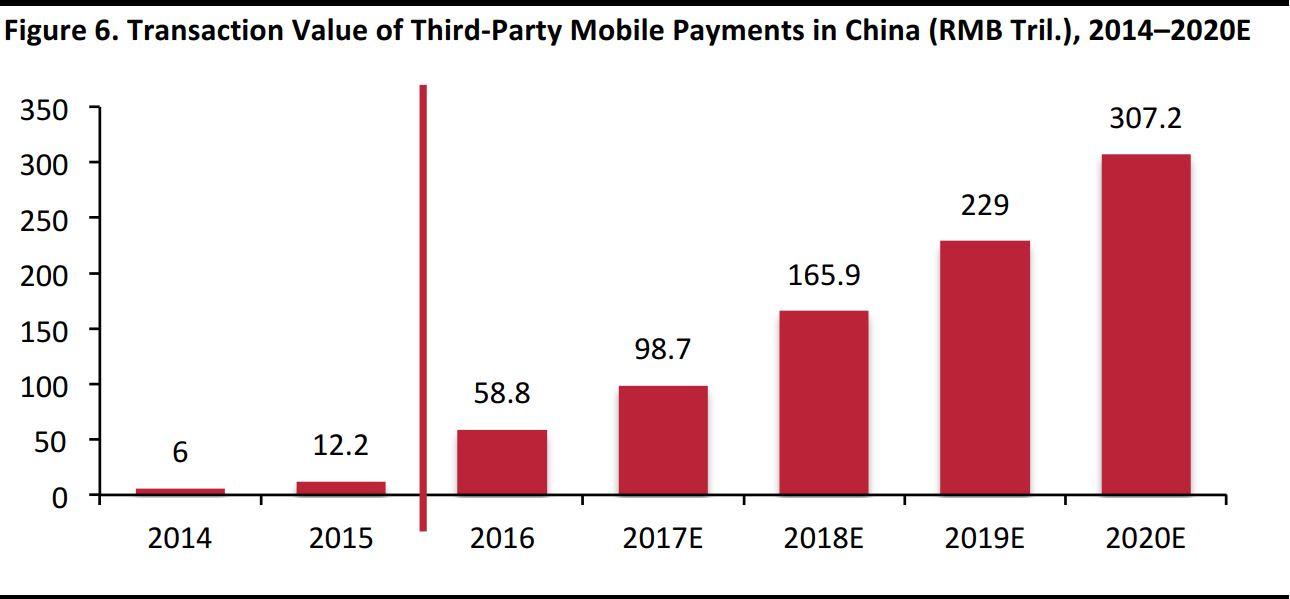 Source: iResearch/Coresight Research
Source: iResearch/Coresight Research
According to research firm Analysys, the market share of the mobile payment market of WeChat’s owner Tencent,which also owns Tenpay, has grown from 16% in the third quarter of 2015 to 39% in the third quarter of 2017, chipping away at Alipay’s dominant 54% market share.
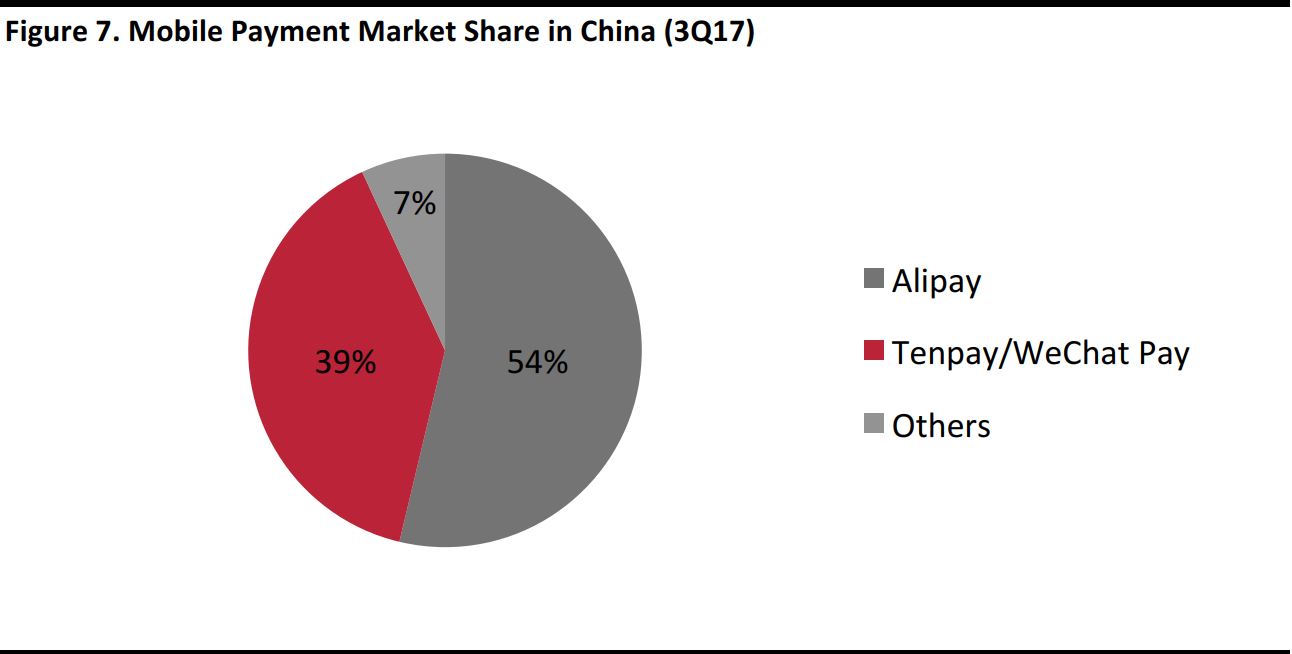 Source: Analysys
Source: Analysys
While Alipay maintains its dominance in the mobile payment market, WeChat Pay has 838 million monthly active users (MAU), almost double that of Alipay’s MAU of 432 million.This confirms the growing popularity of WeChat for sending and receiving money within the app.
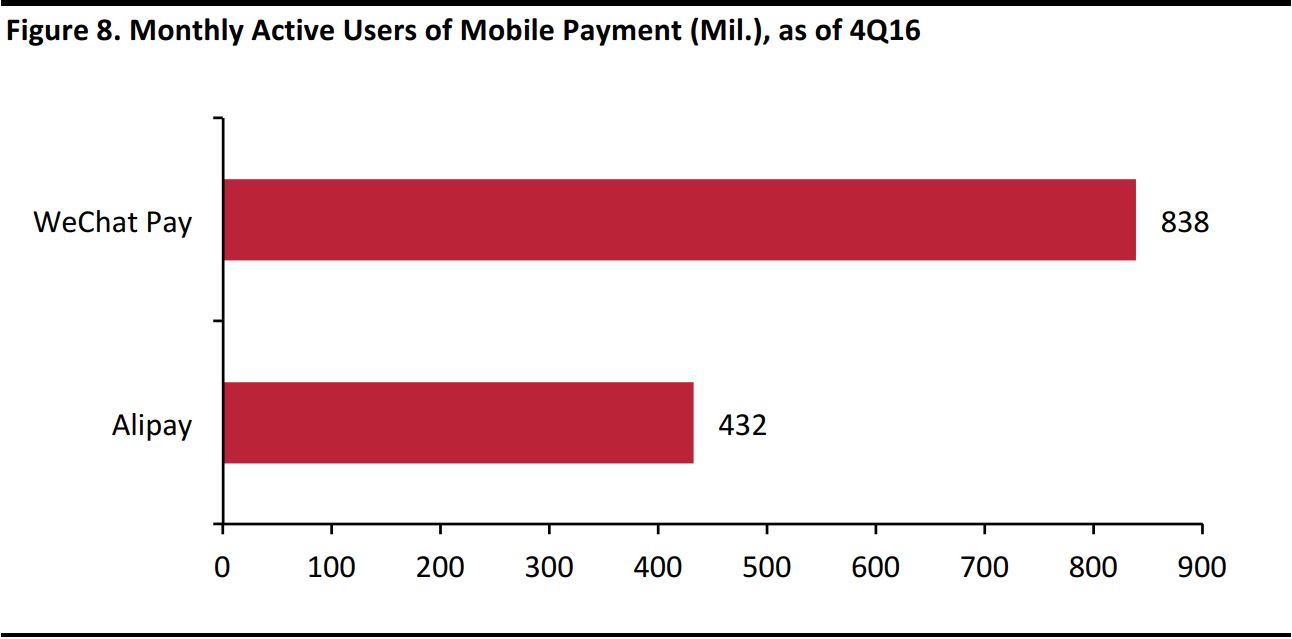 Source: Analysys
Source: Analysys
We believe that WeChat’s instant messaging and social media functions give it an advantage in developing the mobile payment market. With over 1 billion people using WeChat every month, and with the average user spending 66 minutes on the app, people are now used to communicating with each other in the app, and ordering and paying for online or offline services, pivoting off its success with digital red packets.
Key Takeaways
Red packets are traditional cash gifts that Chinese people give each other at Lunar New Year and at important life events such as wedding banquets. WeChat was not only the first to digitalize the giving of red packets, but its gamification of this custom allows WeChat users to send and receive digital red packets for fun and for good wishes,without having to worry about the traditional rules which dictate who to give to and how much to give them.
The popularity of WeChat’s digital red packets has bolstered WeChat’s successful foray into mobile payment, with WeChat users linking their bank account information to the app, and getting them accustomed to sending and receiving money within the app.
Leveraging its success with digital red packets, WeChat has expanded its functions to include money transfer, taxi ordering, online shopping, bill settlement and wealth management, making it an all-in-one app.
We believe WeChat’s broad user base of over 1 billion MAU, as of February 2018, and high degree of user engagement,thanks to its instant-messaging and social media functions, give it a strong competitive edge in mobile payment.


 Source: Coresight Research
Source: Coresight Research Source: Tencent/Bloomberg/Coresight Research
Source: Tencent/Bloomberg/Coresight Research Source: Lightspeed Research
Source: Lightspeed Research Source: Tencent/Tieba
Source: Tencent/Tieba Source: Tencent/Digital Initiative Digest/Coresight Research
Source: Tencent/Digital Initiative Digest/Coresight Research  Source: iResearch/Coresight Research
Source: iResearch/Coresight Research Source: Analysys
Source: Analysys Source: Analysys
Source: Analysys